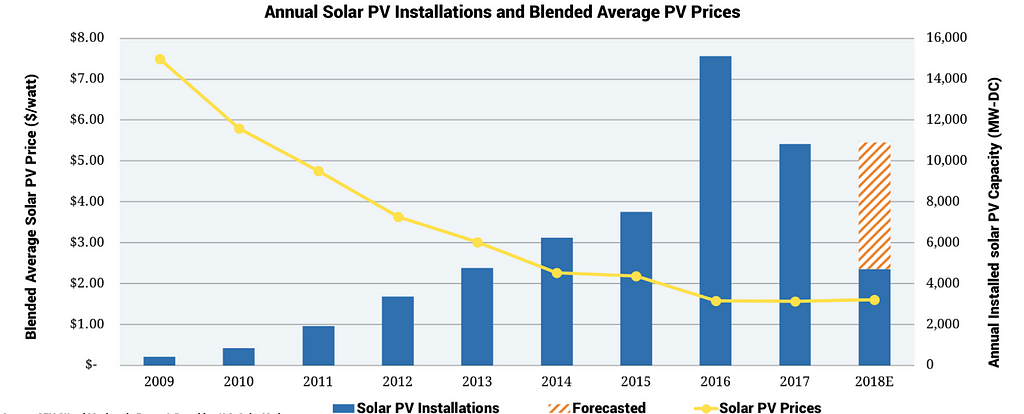Latest news about Bitcoin and all cryptocurrencies. Your daily crypto news habit.

Roughly 10 years ago the vision of a peer-to-peer electronic cash system was published, marking the launch of Bitcoin and the foundation of blockchain. While an explosion of new startups have enamored the cryptocurrency craze, the energy sector has envisioned leveraging blockchain for reasons similar to that of finance — transparency, trust, and automation. I’d like to highlight a few observations (and debunk a myth or two) now that blockchain hype is subsiding and new distributed energy solutions remain scarce.
The youth is starting to change
Many have speculated the crypto-revolution in finance will naturally come for other industries like energy. However, what finance had that energy did not is a disruption moment from mobile and digital — a trend that forced incumbent monopolies to rethink their offerings for younger generations seeking higher convenience, trust, and control. These are contributing drivers of cryptocurrency development thanks to the youth growing into the CEOs and web developers of blockchain projects today.
While a handful of developers focused on revamping money via Bitcoin, energy was changing in a less digital manner. Solar, wind, and storage advancements grew as grid difference makers and drew new network effects of their own (except this network was 100 years old, not 10). If the energy sector is headed for a similar fate of engaging a tech-savvy generation, it too requires serious digital transformation.
Digitization before decentralization? It’s complex.
Cryptocurrency and the future energy landscape share similar goals of decentralization, democratization, and consumer protection. Since the energy grid is a complex web of generators, distributors and operators all moving through a tangled delivery system, it is no wonder use cases have emerged attempting to connect the two. Distributed ledgers have, for better or for worse, drummed up interest as a solution that will push energy players into modern technology adoption.
That idea seems farfetched but I marveled at this two years ago and I’ll reiterate it now — it is incredible distributed ledger development is tackling one of the most complex and highly regulated sectors first. If nothing else to prove that the finance system is overly complicated and disadvantageous to the uninformed, it it admirable work. And it won’t stop with money. If enough brain power is focused on ‘cryptoeconomics’ to build a new financial system, the same can be said for parallel outdated and fragmented systems tied to the electric grid. To quote former Google executive and Yahoo CEO Marissa Mayer, “creativity loves constraint” and few industries are more constrained than energy.
 (Source: Smart Grid Consumer Collaborative 2016 Annual Report)Is the energy sector headed for a similar fate as finance?
(Source: Smart Grid Consumer Collaborative 2016 Annual Report)Is the energy sector headed for a similar fate as finance?
In short, yes. Much of the speculation for energy blockchain is driven by the notion of ‘transactive energy’, or a method by which patchwork grid systems are optimized for new automated services. This could be predictive load balancing, high-accuracy outage management, or energy trading among neighbors. But it’s important to recognize that physical grid assets are mostly dumb infrastructure. Analog sensors, fax machine processes, mainframe billing systems. To much dismay these are the critical backbone operations running our energy grids today. Utilities and operators will improve their digital capabilities at the pace of regulation, while grid edge telecom and consumer-facing energy solutions materialize as smart infrastructure.
I’d be willing to bet smart infrastructure developments lead to competitive products and services that unlock transactive energy prosperity first. These offerings may be the creative plays most appealing to the more energy-conscious and mobile-handcuffed customer of the future, thus fueling energy’s own digital disruptive moment.
Blockchain still has a role to play
Clean and usable data is the doorway to digital transformation and it is time energy act on this need. Unfortunately, energy operators have long read the technology tea leaves but rely on regulatory incentives to drive a change in digital adoption. Although this has long plagued them to delay quality data management practices, this is clearly the bridge to embracing breakthroughs in distributed ledgers in addition to more mature artificial intelligence or customer-facing products. Just as no one blockchain will easily solve all inefficiencies in finance, there will be no quantum leap into an all-in-one energy blockchain network magically replacing the energy systems relied on today.
Data issues aside, we shouldn’t ignore the outstanding pace of innovation among blockchain startups and far-reaching interest in the sector. Projects are forming through global social channels and may bring more uniformity to industry standards. Protocol development is laying the foundation for future application and services that could impact energy down the road. Many regulators, utilities, and energy traders from Europe, Australia, and North America have all taken a special interest in the tech, and I’d be remiss not mentioning the Department of Energy and World Economic Forum also yearning to learn more.
But won’t blockchain consume too much energy?
While I can’t be upset over media outlets running with this headline (it’s an energy-friendly concern) we can’t ignore other technology advancements impact on electricity consumption. Data centers too were once energy-sucking behemoths gearing up for global exponential growth. Fast forward to 2018, cloud computing matured to be cheap, fast, and highly energy efficient.
The Department of Energy’s Lawrence Berkeley National Laboratory has found U.S. data centers consumed 70 billion kilowatt hours in 2014, or about 1.8% of total U.S. electricity consumption in that year. The energy use by data centers only grew 4% between 2010 and 2014. In contrast it grew 90% from 2000 to 2005, and 24% from 2005 to 2010.
Distributed ledgers are no different in my opinion. Although Bitcoin is the most popular and widely adopted network, Ethereum development in 2017 opened the door to less energy-intensive protocols which continue to improve today. Most enterprise blockchain solutions launched to date are based on ethereum code with full recognition cost effective nodes will drive scale.
- p.s. When Bitcoin launched 10 years ago, energy looked astonishingly different*
- In 2008, over half of the electric power sector’s total supply was met from coal
- Less than 5,000 fully electric vehicles were sold in the U.S.
- Renewable energy represented only 9 percent of total supply
- The Tesla Roadster launched, becoming the first production automobile to use lithium-ion battery cells
- The average solar PV price was over $7 per watt, putting an average-sized residential system at more than $40,000
For Energy, It’s Digitization Before Decentralization was originally published in Hacker Noon on Medium, where people are continuing the conversation by highlighting and responding to this story.
Disclaimer
The views and opinions expressed in this article are solely those of the authors and do not reflect the views of Bitcoin Insider. Every investment and trading move involves risk - this is especially true for cryptocurrencies given their volatility. We strongly advise our readers to conduct their own research when making a decision.
